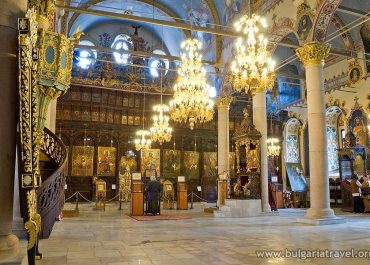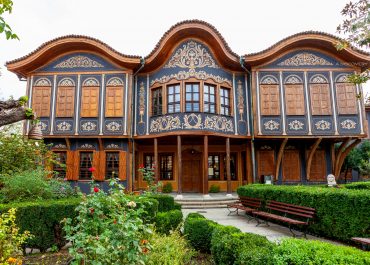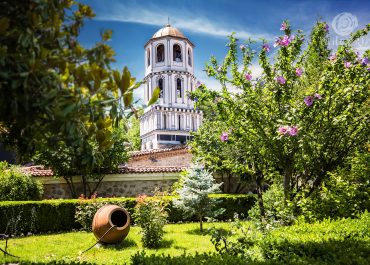
Dzhumaya Mosque – Plovdiv
Dzhumaya Mosque is the main Muslim temple in Plovdiv. Its Turkish name is Hüdavendigâr Camii or Cuma Camii. The mosque is located in the centre of Plovdiv and was built in the place of Sveta Petka Tarnovska Cathedral Church soon after the town was conquered by the Ottoman army (1363 – 1364). During the reign of Sultan Murad II (1421 – 1451) the old building was demolished and replaced by the modern-day mosque. It was called Ulu Dzhumaya Mosque, i.e. main Friday mosque.
Dzhumaya Mosque is one of the oldest Ottoman religious buildings on the Balkans. It is also one of the biggest: an imposing rectangular building with a 33 m-by-27 m prayer hall. It reveals influences from Byzantine and old Bulgarian architectural techniques: two layers of brick laid on top of each layer of cut stone.
In contrast to later single-domed mosques, the Dzhumaya belongs to the so-called multi-domed mosques. It has nine domes covered with sheets of lead. A minaret is erected at the northeast corner of the main facade, decorated with a diagonal square meshwork of red bricks on white mortar plaster.
The interior of the mosque is decorated with floral ornament wall-paintings, such as twigs, blossoms and garlands that are intertwined with medallions quoting the Koran.
The wall-paintings probably date back to the end of the 18th century and the beginning of the 19th century. Parallels can be drawn between the exterior and the interior of Dzhumaya Mosque and some of the oldest Ottoman religious monuments in Bursa, Edirne, and Sofia built in the 14th – 15th centuries.
Plovdiv, Jumayatа square, st. Zhelezarska, 2
It is located in the very center of Plovdiv – on Jumayatа Square.
The temple is run by an imam who speaks Bulgarian and Turkish.
Tourist Information Center – 1, Rayko Daskalov Str. /Roman stadium sq./
Monday – Sunday
9:00 – 22:00 /summer working time/
9:00 – 20:00 /winter working time/
Tel: +359 32 620 229
Website: visitplovdiv.com
Tourist Information Center -1, D-r Stoyan Chomakov Str. /The Оld town/
Monday – Sunday
9:00 – 18:00 /summer working time/
9:00 – 17:30 /winter working time/
Tel: +359 32 620 229
Website: www.visitplovdiv.com
Dzhumaya Mosque is the main Muslim temple in Plovdiv. Its Turkish name is Hüdavendigâr Camii or Cuma Camii. The mosque is located in the centre of Plovdiv and was built in the place of Sveta Petka Tarnovska Cathedral Church soon after the town was conquered by the Ottoman army (1363 – 1364). During the reign of Sultan Murad II (1421 – 1451) the old building was demolished and replaced by the modern-day mosque. It was called Ulu Dzhumaya Mosque, i.e. main Friday mosque.
Dzhumaya Mosque is one of the oldest Ottoman religious buildings on the Balkans. It is also one of the biggest: an imposing rectangular building with a 33 m-by-27 m prayer hall. It reveals influences from Byzantine and old Bulgarian architectural techniques: two layers of brick laid on top of each layer of cut stone.
In contrast to later single-domed mosques, the Dzhumaya belongs to the so-called multi-domed mosques. It has nine domes covered with sheets of lead. A minaret is erected at the northeast corner of the main facade, decorated with a diagonal square meshwork of red bricks on white mortar plaster.
The interior of the mosque is decorated with floral ornament wall-paintings, such as twigs, blossoms and garlands that are intertwined with medallions quoting the Koran.
The wall-paintings probably date back to the end of the 18th century and the beginning of the 19th century. Parallels can be drawn between the exterior and the interior of Dzhumaya Mosque and some of the oldest Ottoman religious monuments in Bursa, Edirne, and Sofia built in the 14th – 15th centuries.
Plovdiv, Jumayatа square, st. Zhelezarska, 2
It is located in the very center of Plovdiv – on Jumayatа Square.
The temple is run by an imam who speaks Bulgarian and Turkish.
Tourist Information Center – 1, Rayko Daskalov Str. /Roman stadium sq./
Monday – Sunday
9:00 – 22:00 /summer working time/
9:00 – 20:00 /winter working time/
Tel: +359 32 620 229
Website: visitplovdiv.com
Tourist Information Center -1, D-r Stoyan Chomakov Str. /The Оld town/
Monday – Sunday
9:00 – 18:00 /summer working time/
9:00 – 17:30 /winter working time/
Tel: +359 32 620 229
Website: www.visitplovdiv.com
Virtual map
Photos
© All images, advertising and video materials and/or other information published on this website are property of the Ministry of Tourism and are protected by the Law on Copyright and Related Rights, according to the Bulgarian laws to all applicable international and relevant acts of the European Union.





